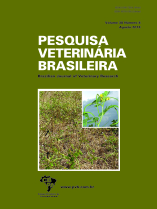 |
|
|
|
Year 2018 - Volume 38, Number 8
|

|
Occurrence of brucellosis, leptospirosis and neosporosis in cows with retained placenta in Southwest Paraná, Brazil, 38(8):1537-1542
|
ABSTRACT.- Porto Y.F., Pinto Neto A., Bernardi F., Possa M.G., Mota M.F., Martinez A.C., Merlini L.S. & Berber R.C. 2018. Occurrence of brucellosis, leptospirosis and neosporosis in cows with retained placenta in Southwest Paraná, Brazil. [Ocorrência de brucelose, leptospirose e neosporose em vacas com retenção de placenta no Sudoeste do Paraná, Brasil] Pesquisa Veterinária Brasileira 38(8):1537-1542. Curso de Medicina Veterinária, Universidade Federal da Fronteira Sul, Campus Realeza, Av. Edmundo Gaievisky 1000, Realeza, PR 85770-000, Brazil. E-mail: adalgiza.uffs@gmail.com
The aim of this study was to measure the occurrence of brucellosis, leptospirosis and neosporosis in cows from 25 family farms milk, with semi-intensive grazing system, located in the Southwest region of Paraná, Brazil. Eighty-four cows with retained placenta, between July 2013 to July 2014, diagnosed by the presence of fetal membranes in the uterus up to 12 hours after partum, decrease of appetite and of milk production, as well increase of rectal temperature were included into the study. The animals were submitted to blood collection for evaluating the seropositivity for brucellosis, leptospirosis and neosporosis. The blood was collected at 15 to 45 days postpartum, avoiding false negative results due to immune deficiency observed in the transition period. After collection, the blood was centrifuged, the serum was packed in three aliquots, identified and subsequently frozen. Serology was performed to diagnose brucellosis (technique of buffered acidified antigen), leptospirosis (through the microscopic agglutination test - MAT) and neosporosis (indirect immunofluorescence test). Animals were considered positive when presenting titer >1:100 (leptospirosis) and 1:200 (neosporosis). No animal with placenta retention presented Brucella abortus bacteria; 39% (33/84) were reactive to one or more Leptospira serovars, 15% (13/84) were positive to Neospora caninum, and 4% (4/84) had both diagnosis, being reactive for leptospirosis and neosporosis. In conclusion, data from this experiment inspires greater attention to leptospirosis and neosporosis in dairy cattle presenting placenta retention in southwest Paraná. |
| |
|
|
| |
|
 |